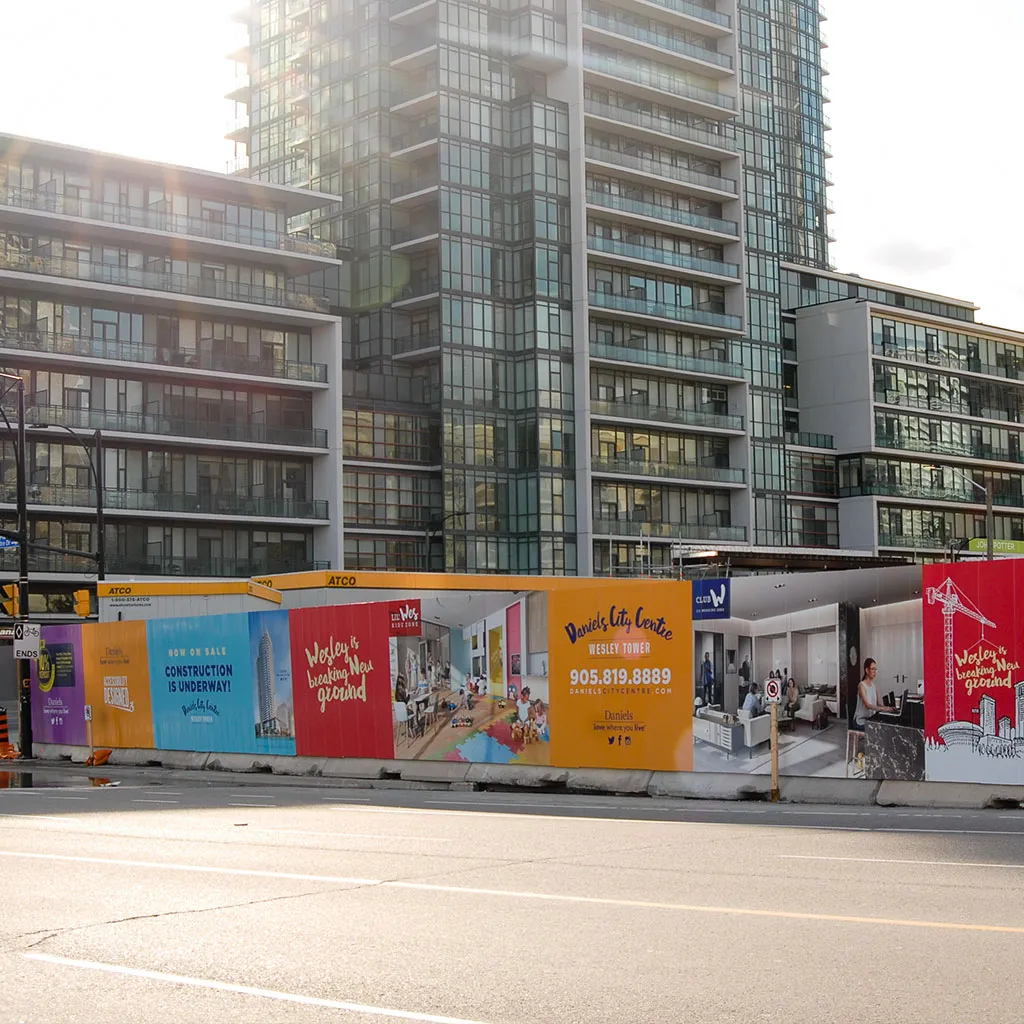Picture a bustling construction site, buzzing with activity. Amidst all the chaos, there’s a hidden hero at work—hoarding. It’s not the kind you might think of in your basement, but a vital element that keeps workers safe, secures the site, and minimizes disruption to the surrounding area.
Hoarding Meaning in Construction
Imagine a construction site as a beehive of activity – exciting, but potentially chaotic. That’s where hoarding comes in. Think of it as a protective shell, a temporary barrier erected around construction sites, that keeps things organized, safe, and looking sharp.
Instead of just plain fences, construction hoarding acts like a sturdy barrier that does so much more:
- Keeps everyone safe: It stops curious folks from wandering in and potentially getting hurt.
- Protects the neighborhood: Noisy construction is a drag, so hoarding helps muffle the sounds and keeps dust clouds from taking over.
- Provides some privacy: It shields ongoing work from prying eyes, giving the construction crew space to focus.
But here’s where it gets interesting: hoarding isn’t just a practical necessity, it’s an opportunity! You can get creative and turn it into a giant canvas:
- Show off your brand: Splash your company logo and colors across the hoarding to make a statement and build brand recognition.
- Go digital and interactive: Forget boring old walls! Modern hoarding can feature digital screens, displaying cool project updates or even interactive elements.
- Be kind to the planet: We all want a greener future, and thankfully, hoarding can be made from recycled materials or designed for easy disassembly and reuse. Some even have solar panels!
And the benefits don’t stop there:
- Tech to the rescue: Imagine sensors embedded within the hoarding that detect potential hazards and alert the crew instantly. Safety just got smarter!
- Turning barriers into bridges: Hoarding can transform into temporary community spaces. Think vibrant murals, public art installations, or even mini-parks – bringing people together instead of dividing them.
- The human touch: While we focus on the physical aspects, it’s worth exploring how hoarding impacts the well-being of both construction workers and the surrounding community. A little splash of color and creativity can go a long way!
Key Points of Hoarding in Construction:
- Safety and Protection: Provides a protective barrier to prevent injuries and protect the surrounding neighborhood from noise and dust.
- Privacy and Focus: Shields ongoing work from prying eyes, allowing construction crews to focus.
- Branding and Recognition: Can be used to display company logos and colors, building brand awareness.
- Digital Integration: Can incorporate digital screens for project updates and interactive elements.
- Sustainability: Made from recycled materials, designed for reuse, and even feature solar panels.
- Technological Advancements: Sensors embedded within hoarding can detect hazards and enhance safety.
- Community Engagement: Can be transformed into temporary community spaces, such as murals or mini-parks.
- Well-being: Color and creativity can positively impact the well-being of workers and the community.
- Essential for Construction: Provides safety, organization, and a professional appearance.
- Customization and Innovation: Encourages creativity in design, materials, and technology.
- Community Building: Has the potential to foster community spirit and enhance urban environments.
What are the different types of construction hoarding?
We’ve talked about what construction hoarding is – that trusty barrier around building sites that keeps things safe, tidy, and looking sharp. Now, let’s dive into the different types you might come across. It’s like choosing the right fence for your backyard, just on a much bigger scale!
1. The Sturdy Stuff: Plywood Hoarding
Think of plywood hoarding as the workhorse of the construction world. It’s built to last, using large sheets of plywood bolted onto a strong frame. This is the go-to choice for those big construction projects where you need something super durable.
But it’s not just about strength. Plywood hoarding can be surprisingly versatile. Need to keep an eye on things? Add some windows! Want easy access? Build in a door! You can even paint it to blend in with the surroundings or get creative and add some artwork.
2. The Quick-Change Artist: Temporary Fencing
If plywood hoarding is the reliable friend, temporary fencing is the adaptable one, always ready to go where it’s needed. Made from metal or plastic panels, it’s lightweight and easy to put up, take down, and move around. This makes it perfect for smaller projects, areas with limited space, or situations where you need to adjust the barrier as work progresses.
Think of it like this: temporary fencing is great for short-term projects or for creating flexible boundaries within a larger construction site.
Choosing the Right Hoarding for the Job
Just like you wouldn’t use a chain-link fence to keep toddlers in (hopefully!), you wouldn’t use just any type of hoarding for every construction project.
- Size Matters: Got a massive skyscraper in the works? Plywood hoarding is probably your best bet. Refurbishing a small storefront? Temporary fencing might be all you need.
- Location, Location, Location: Building in a busy city center? You’ll want something sturdy and secure like plywood. Out in the open countryside? Temporary fencing could be a more practical choice.
Ultimately, the best way to decide is to talk to the experts. A qualified contractor can assess your specific needs and recommend the most suitable type of construction hoarding for your project.
How do you choose the right hoarding for your construction project?
Alright, so you’ve got your construction project all planned out, but have you given much thought to the hoarding? You know, those temporary walls that go up around construction sites? It might seem kinda boring, but trust me, choosing the right hoarding is super important! It keeps your site safe and secure, protects everyone passing by, and even makes the place look a bit tidier amidst all the chaos.
Let’s break down how to pick the perfect hoarding for your project:
1. Size Up Your Project:
First things first, how big is your construction playground? If you’re working on a smaller project, like a home renovation, you might be good with some simple temporary fencing. Think of it like putting up a little fence around a garden. But for those massive projects that take up a whole city block, you’ll need something much sturdier and more permanent. Imagine trying to contain a real-life game of Tetris with a flimsy fence – not gonna end well!
2. Location, Location, Location:
Where you’re building plays a big role too. If your project is in a busy downtown area with lots of foot traffic, you’ll need some seriously strong and durable hoarding. You don’t want anything falling over or causing a safety hazard with people walking by. On the other hand, if you’re out in a more open, rural area, you might have a bit more flexibility to use something less intense.
3. Show Me the Money (Or Your Budget):
Let’s be real, your budget will definitely influence your hoarding options. The good news is, there are tons of different types of hoarding out there, from basic to fancy, so you can find something to fit your budget. It’s like choosing between a hostel and a five-star hotel – both offer a place to sleep, but the experience and price tag are quite different!
4. Shop Around for the Best Deals:
Just like buying a car or a new phone, don’t settle for the first hoarding option you find. Get quotes from a few different suppliers to compare prices and find the best bang for your buck. You might be surprised by the price differences!
5. Decision Time:
Once you’ve weighed all these factors – size, location, budget, and quotes – it’s time to make a decision. Think of it like putting together a puzzle, where each piece represents a different consideration. Once you have all the pieces in place, you can see the full picture and make the smartest choice.
Remember: This might just be a temporary wall, but it plays a big role in the safety and success of your construction project. Choosing wisely can save you headaches and money in the long run!
What are the Safety Regulations for Construction Hoarding?
We’ve already talked about how important construction hoarding is, but let’s dive into the specific rules and regulations that make it effective. Think of these as the guidelines that ensure these temporary barriers do their job of keeping everyone safe and sound.
First things first, height matters. The hoarding needs to be tall enough to discourage anyone from trying to climb over it – because let’s be honest, construction sites are full of potential hazards we want to keep people away from. But it’s not just about height; visibility is key too. Bright colors and reflective materials are like beacons, making the hoarding easy to spot, even in low light.
Next up, let’s talk materials. We’re talking sturdy stuff here, like plywood, steel, or tough plastics. It’s gotta be strong enough to withstand wind, weather, and the occasional bump or nudge. And of course, it needs to be securely fastened – nobody wants a rogue panel flying off!
Now, about those entrances and exits. Construction sites need controlled access points, and that’s where gates or designated openings in the hoarding come in. These allow authorized personnel (think workers, inspectors, and the like) to get in and out safely, while preventing anyone without authorization from wandering in.
Finally, let’s shed some light (literally!) on signage and illumination. Hoarding is prime real estate for important information – warning signs, project details, emergency contacts – you name it. And because visibility is crucial, especially at night or in gloomy weather, adequate lighting is a must.
Here’s the bottom line:
- Safety First: Construction hoarding is all about preventing accidents and unauthorized access.
- Rules and Regs: Everything from the hoarding’s height and material to its visibility and access points is governed by regulations.
- Information is Power: Signage and lighting aren’t just safety features; they’re also vital for communication on a construction site.
For a deep dive into the official guidelines, check out The Construction (Design and Management) Regulations 2015.
For a step-by-step guide on constructing highways in civil engineering, refer to our detailed article on how to make highway step wise in civil.
For insights into the processes involved in constructing asphalt concrete roads, visit our page on process involves in construction of asphalt concrete road.
- Best Backsplash For White Cabinets: Ideas To Transform Your Kitchen - November 24, 2025
- Modern White Kitchen Backsplash: A Guide to Stylish Kitchen Designs - November 23, 2025
- White Backsplash Ideas: Simple Ways to Refresh Your Kitchen Space - November 22, 2025










